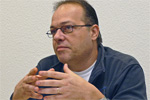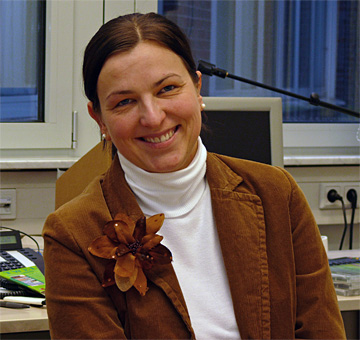Training by GM & FST Efstratios Grivas
Schedule – Hamburg, 22.01.2011
| 10:30-10:50 |
Physical and Psychological Factors; Getting to know Ourselves |
11:00-11:50 |
Building a Repertoire; Chess Literature |
12:00-12:50 |
Activity of Bishops and Knights |
Break |
|
14:00-14:50 |
The Backward Pawn |
15:00-15:50 |
The Art of Exchanges |
16:00-16:50 |
The Golden Rules of the Endgame; How to Think in Endgames |
The aim of this series of lectures is to enable participants to teach young
and gifted players in schools and chess clubs, and to educate trainers and chess
teachers not only in their own countries but also on an international basis.

Successful chess trainer GM Efstratios Grivas
The material started to develop in early 2004 and was used Grivas' personal
training sessions, where he developed a system based on serious sport (chess
is treated like a sport) and chess material (focusing on middlegame and endgame).
In 2005 this material was first printed in Greek, in a series of training books
called ‘Skakistiki Proponisi’ (six volumes, 680 pages). It then
appeared in an improved version in an English series ‘Chess
College’ (Gambit 2006, three volumes, translator Sotiris Logothetis)
and ‘Practical
Endgame Play’ (Everyman 2008). It was also translated (in another
improved version) into Turkish in 2009. Finally a further improved version appeared
in the latest FIDE book for training the trainers called ‘Syllabus’
(FIDE 2010, proofer Andrew Martin).
"I use this material to make my students understand that health and other
sport assets are valuable for a chess player's improvement, and not just never-end
analysis in openings," says Stratos (as his friends call him). "For
example in Turkey, where I am working on my program, all my trainees exercise
some physical activity in accordance with their chess education." Since
middle of 2006, when he started training youthful Turkish talents, three players
have made their grandmaster norms and two more are close to this goal. And a
number of IMs have also arisen in the process.
In the meantime Grivas, Adrian Mikhalchishin, Alexander Beliavsky and Georg
Mohr are cooperating to produce a total training system, which will appear in
30 books (around 3,000 pages) based on the idea of full training in the middle
and endgame. The work is being edited by the Turkish Chess Federation (which
has the rights) and for the moment it is printed only in the Turkish language.
The project started in early 2010 and it will be completed in 2012.
Trainers (and players) all over the world can use the series presented on
the ChessBase news page freely. Any question can be addressed directly to the
author: GrivasEfs (at) yahoo.co.uk.
The start
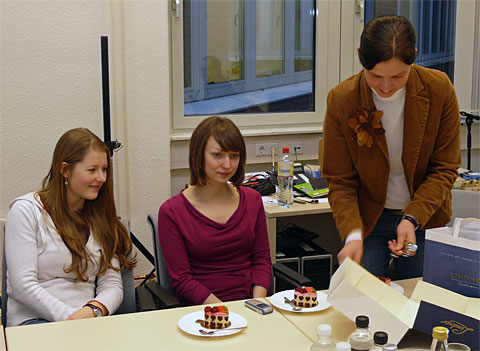
The training session in Hamburg started with something delicious. One of
the participants, WGM
Marta Michna, was celebrating her daughter's birthday and brought some Lindner
cake for everyone.

Piece o' cake! Training with Efstratios Grivas and Marta Michna is quite
enjoyable
Marta was born in Poland and started her career as Marta Zielinska and played
for her country in four Olympiads. She now lives in Hamburg and played at the
last Olympiad for Germany, where she is the second-highest ranked female player
in the country.
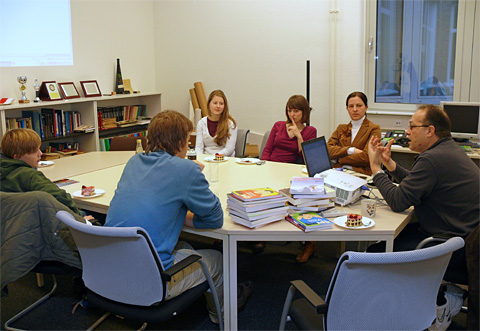
After the cake the training session can begin
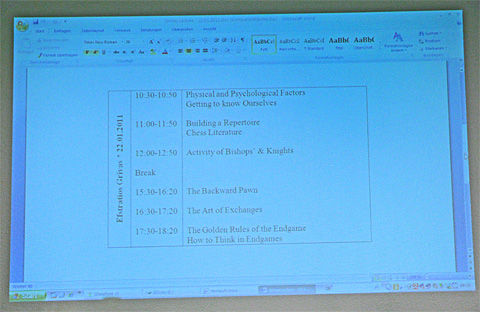
The program for the day, projected on the screen
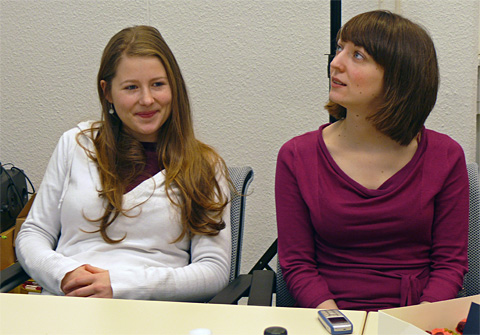
WIM Melanie Ohme, 20, has been the poster girl for German chess since her
pre-teen days. IM and WGM Elisabeth Pähtz, who has just turned 26, is the
highest ranked female player in Germany. "Elli" is the daughter of
GM Thomas Pähtz and at nine won her won her first German championship in
the under-11 age group. In 2005 she won the World Junior Chess Championship
for girls.
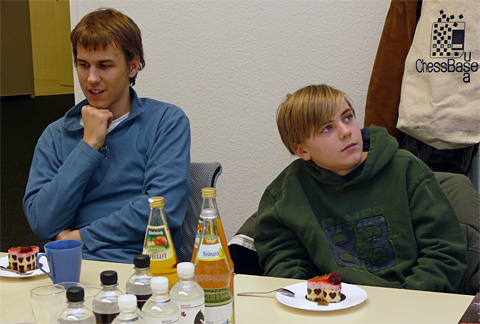
FM Hagen Poetsch, 19, is rated 2408. Jonas Lampert is 13 and rated
2127
Physical and Psychological Factors
Which physical and psychological assets are necessary for a successful chess
career? Well, in the next pages we will be well informed on various subjects
concerning a healthy sportsman’s life.
Chess Assets
On the basis of relevant research conducted since the beginning of the previous
century, these assets are split in two main categories, innate and attainable.
Innate Chess Assets
- Self-control
- Ability to think on subjects
- Intense mental activity
- Obedience of will
- Proper distribution of attention
- Perception of position dynamics
- Combinative creative skill
Attainable Chess Assets
- Good health condition
- Strong nerves
- Perception of data conveyed by our senses
- Objective thought-process
- Powerful memory
- High mental level
- Self-confidence
- Control of emotional urges
- Feeling for the position (combination of thought and emotions)
The innate assets can be further enhanced and developed, but the attainable
ones are purely a matter of education. Endless work and systematic training
in order to improve our personal traits and the 'required assets' is essential
for our overall chess improvement and the climb up to the highest title; that
of grandmaster.
Naturally, without the help of a specialized trainer or advisor, the trainee
finds it difficult to understand or try to improve the above-mentioned assets.
After all, these assets are exclusively related to chess and have no direct
bearing on our other interests. For example, 'powerful special memory' may refer
exclusively to chess-related matters (data), as opposed to other matters; naturally,
the opposite is also possible. Each of us is unique.
Health Sports
Chess-players tend to grossly ignore the proper state of their health, consequently
being in serious danger of suffering heart problems due to the combination of
lack of physical training and daily stress stemming from preparation for and
participation in competitions. Therefore, workout or sport activities in general
is essential, not only to protect our precious health but also to ensure better
results over a longer period of time.
Man's first kinetic activity, walking, does not require any specialized equipment,
can take place everywhere and brings several dividends. It is one of the simplest
methods of aerobic training, improving cardiac and respiratory functionality,
and our physical condition in general. A routine of half an hour of walking
and two hours at the gym can turn our biological clock six to eight years back.
At the same time, it contributes to proper maintenance of weight and forestalls
obesity. Finally, it helps reduce the amount of bad cholesterol (LDL) in our
body. Research conducted by American universities has proven that this activity
improves memory and mental focus, while the production of endorphins (substances
that reduce physical and emotional pain, as well as creating euphoria) reaches
extremely high levels.
Training time-frame
Another topic that must be addressed is the 'time-frame' of training in relation
to the scale of our mental activities, and how we are able to attain maximum
performance in it. Science almost unanimously accepts the following categorization
of people:
-
Larks: their mental processes are most efficient during the first
half of the day, falling off during the second half. Approximately 25% of
the world's population belongs in this category.
-
Owls: their mental processes are most efficient during the second
half of the day and especially during the evening hours. They usually go
to sleep late and wake up accordingly late. Approximately 30% of the world's
population belongs in this category.
-
Arrhythmics: for these people mental processes do not display any
special ups and downs during the day or night. Approximately 45% of the
world's population, the largest part, belongs to this category.
In practice, all top chess-players belong to the 'Owls' category! The explanation
is simple and is directly related to the standard time-frame of chess competitions,
which mostly take place during the second half of the day. Therefore, the chess-player
'must' place himself in this category (as far as possible) and adapt his training
schedule accordingly.
But of course, if it is not easy to be adjusted in this ‘new’ time-frame, solutions
exist. One of the most ‘used’ one for chess-players who are fundamentally larks
is to take a nap in-between lunch and play, usually for 1 to 1½ hour. Then the
mind is fresh again and ready to fight!
Nutrition
Another important topic is the chess-player's nutritional habits. In general
he should not deviate from his customary diet as regards the type and quantity
of food he consumes (no exertions!), as each organism has different needs and
habits.
What can chessplayers do in order to improve and/or maintain healthy habits?
Some very simple rules to be followed by young people are: proper lifestyle,
proper sleeping patterns, consumption (in logical portions) of a variety of
vegetables, fruits and natural fibres, along with one's favourite dishes involving
fish, beef, chicken, ham and turkey. In other words, a healthy diet based on
a variety of food, based on a weekly schedule. Soy milk, filtered water, tea
(especially black or green), coffee, dairy products (such as butter, milk, eggs
and cheese) should be rarely consumed within each week.
In our times, one dish rarely contains sufficient amounts of vitamins and minerals.
Normally, a specialized food shop can provide a nutritional supplement to meet
one's specific needs. Although these supplements are costly, just consider how
much harm an illness or sickness can do to your game. So, a question is been
borne by all the above: what is the best diet for a chess-player, a sportsman?
According to Rebecca
Scritchfield (among others), following a healthy diet can be a key method
of preventing heart disease. We can highlight five heart-healthy foods that
can literally save our health. We recognize that these are not the only five
foods that protect our heart, but they stand out as star performers and great
additions to any diet.
-
Garlic: This herb is ideal for heart health. Numerous studies have
shown the potential benefits of regular garlic consumption on blood pressure,
platelet aggregation, serum triglyceride level, and cholesterol levels –
all of which keep our heart performing. Garlic also makes a great seasoning
for food so we can greatly reduce salt.
-
Salmon: Make the swap from a saturated fat burger to a salmon fillet.
While some saturated fat is fine, a little goes a long way. The average
cheeseburger has more than half a day worth of the artery clogging fat,
which will increase our risk for a heart attack. Conversely, salmon lowers
that risk thanks to heart healthy fats. Omega-3s can prevent erratic heart
rhythms, reduce likelihood of blood clots inside arteries, improve the ratio
of good cholesterol to bad cholesterol, and prevent cholesterol from becoming
damaged, at which point it clogs arteries. Also, a combination of Omega-3
(fish oils), Omega-6 (borage oil) and Omega-9 (olive oil) looks excellent!
-
Berries and Cherries: Props must be given to nature’s candy. These
sweet treats are high in polyphenols, which prevent cell damage that creates
unhealthy blood vessels and heart. During the winter we can opt for frozen
berries. Try thawing a bag of frozen strawberries in the refrigerator. Then,
add unsweetened, steel-cut oatmeal with the berries their juice and your
heart will say thanks with each beat.
-
Quinoa: Often mistaken as a grain, this tiny sprouted seed is an
excellent source of magnesium, the mineral that relaxes blood vessels. Low
dietary levels of magnesium lead to some scary health issues like increased
rates of hypertension, ischemic heart disease and heart arrhythmias. Quinoa
cooks quickly and makes great leftovers. Toss with grilled veggies and roasted
chicken for a delicious one-pot dinner, or try the Red
Curry Quinoa
recipe.
-
Hot Cocoa: Hot cocoa is brimming with antioxidants – two-times
more than red wine and three times more than green tea. The cool temperatures
are no match for a mug of hot cocoa. A tip: since hot chocolate mixes are
full of sugar, use 100% cocoa and combine with a teaspoon of sugar. Plus
you'll sweeten with the natural sugars in the milk.
Special attention must be paid to the fact that many chess-players mistakenly
support the concept of the 'empty stomach' during competitions. Consumption
of food should take place 60-90 minutes before the start of play, as this time
ensures the possibility of adequate absorption of the food, consequently providing
the brain with 'fuel'. During the game one may consume small amounts of caffeine
(1-2 cups of coffee or tea) as well as chocolate, which is quickly absorbed
by our metabolism (in 2-3 minutes); this does not mean that any other light
food is less useful. It is self-evident that alcohol is strictly forbidden.
Conclusion
You may be wondering how all this is related to your chess. But think about
it. When you feel healthy, full of life and in spiritual upheaval, the four
main emotional attributes of self-confidence, experience, concentration and
adaptability strongly come to the fore. When your body and mind are in perfect
shape, so will your chess.
Further lectures to follow...
Efstratios Grivas
Efstratios Grivas is a grandmaster and highly experienced chess trainer
and chess author.
e lives in Athens, and he is also a FIDE Senior Trainer (Secretary of
the FIDE Trainers' Commission), an International FIDE Chess Arbiter and
an International FIDE Chess Organizer. He has represented his country
on a great many occasions, winning the fourth position in the World Junior
Championship 1985, an individual gold medal at the 1989 European Team
Championship and an individual silver medal at the 1998 Olympiad.
In 2010 he was awarded the worldwide highly important FIDE TRG Awards
– the Boleslavsky Medal (best author) for 2009. |
 |
Copyright
Grivas/ChessBase
